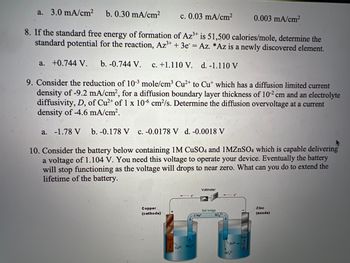
Chemistry
10th Edition
ISBN: 9781305957404
Author: Steven S. Zumdahl, Susan A. Zumdahl, Donald J. DeCoste
Publisher: Cengage Learning
expand_more
expand_more
format_list_bulleted
Question
Solve 9 please

Transcribed Image Text:**Transcription for Educational Website**
---
**7. Consider the following current densities:**
a. 3.0 mA/cm²
b. 0.30 mA/cm²
c. 0.03 mA/cm²
d. 0.003 mA/cm²
---
**8. If the standard free energy of formation of Az³⁺ is 51,500 calories/mole, determine the standard potential for the reaction, Az³⁺ + 3e⁻ = Az. *Az is a newly discovered element.**
a. +0.744 V
b. -0.744 V
c. +1.110 V
d. -1.110 V
---
**9. Consider the reduction of 10⁻³ mole/cm³ Cu²⁺ to Cu⁺ which has a diffusion-limited current density of -9.2 mA/cm², for a diffusion boundary layer thickness of 10⁻² cm and an electrolyte diffusivity, D, of Cu²⁺ of 1 x 10⁻⁶ cm²/s. Determine the diffusion overvoltage at a current density of -4.6 mA/cm².**
a. -1.78 V
b. -0.178 V
c. -0.0178 V
d. -0.0018 V
---
**10. Consider the battery below containing 1M CuSO₄ and 1M ZnSO₄ which is capable of delivering a voltage of 1.104 V. You need this voltage to operate your device. Eventually, the battery will stop functioning as the voltage will drop to near zero. What can you do to extend the lifetime of the battery?**
---
**Diagram Explanation:**
The diagram shows a galvanic cell setup:
- **Copper (cathode)**: The left side contains a copper electrode submerged in a CuSO₄ solution.
- **Zinc (anode)**: The right side contains a zinc electrode submerged in a ZnSO₄ solution.
- **Salt bridge**: Positioned between the two solutions, it allows the flow of ions without mixing the solutions directly.
- **Voltmeter**: Connected across the electrodes to measure the voltage.
This setup illustrates the basic operation of a galvanic cell, where chemical energy is converted into electrical energy.
---
This transcription provides a detailed explanation of the concepts, enhancing
Expert Solution
arrow_forward
Step 1: step 1 of 2
9. To solve this problem, we can use the following equation:
where:
- η_d is the diffusion overvoltage
- R is the universal gas constant
- T is the temperature in Kelvin
- n is the number of electrons transferred in the electrochemical reaction
- F is Faraday's constant
- j is the current density
- j_lim is the limiting current density
Step by stepSolved in 3 steps

Knowledge Booster
Similar questions
- Please answer question number 1 correctly with the correct answer. there is a picture of an example of a ''Dimensional analysis Format' below. please write out all work showing the math in dimensional analysis format. Question 2: What is the molar mass of each of the following compounds? A. Phosphorus Pentachloride (PCl5) B. Uranium Hexafluoride (UF6)arrow_forwardA sample of metal weighing 1.4 g is combined with oxygen; the metal oxide weighs 33.5 g. The mass percent of oxygen in the compound is _____.arrow_forwardPlease answer question below correctly with the correct answer. there is a picture of an example of a ''Dimensional analysis Format' below. please write out all work showing the math in dimensional analysis format. (please show all work) Question: How many grams are in 0.658 mol of calcium phosphate {Ca3(PO4)2}arrow_forward
arrow_back_ios
arrow_forward_ios
Recommended textbooks for you
 ChemistryChemistryISBN:9781305957404Author:Steven S. Zumdahl, Susan A. Zumdahl, Donald J. DeCostePublisher:Cengage Learning
ChemistryChemistryISBN:9781305957404Author:Steven S. Zumdahl, Susan A. Zumdahl, Donald J. DeCostePublisher:Cengage Learning ChemistryChemistryISBN:9781259911156Author:Raymond Chang Dr., Jason Overby ProfessorPublisher:McGraw-Hill Education
ChemistryChemistryISBN:9781259911156Author:Raymond Chang Dr., Jason Overby ProfessorPublisher:McGraw-Hill Education Principles of Instrumental AnalysisChemistryISBN:9781305577213Author:Douglas A. Skoog, F. James Holler, Stanley R. CrouchPublisher:Cengage Learning
Principles of Instrumental AnalysisChemistryISBN:9781305577213Author:Douglas A. Skoog, F. James Holler, Stanley R. CrouchPublisher:Cengage Learning Organic ChemistryChemistryISBN:9780078021558Author:Janice Gorzynski Smith Dr.Publisher:McGraw-Hill Education
Organic ChemistryChemistryISBN:9780078021558Author:Janice Gorzynski Smith Dr.Publisher:McGraw-Hill Education Chemistry: Principles and ReactionsChemistryISBN:9781305079373Author:William L. Masterton, Cecile N. HurleyPublisher:Cengage Learning
Chemistry: Principles and ReactionsChemistryISBN:9781305079373Author:William L. Masterton, Cecile N. HurleyPublisher:Cengage Learning Elementary Principles of Chemical Processes, Bind...ChemistryISBN:9781118431221Author:Richard M. Felder, Ronald W. Rousseau, Lisa G. BullardPublisher:WILEY
Elementary Principles of Chemical Processes, Bind...ChemistryISBN:9781118431221Author:Richard M. Felder, Ronald W. Rousseau, Lisa G. BullardPublisher:WILEY

Chemistry
Chemistry
ISBN:9781305957404
Author:Steven S. Zumdahl, Susan A. Zumdahl, Donald J. DeCoste
Publisher:Cengage Learning

Chemistry
Chemistry
ISBN:9781259911156
Author:Raymond Chang Dr., Jason Overby Professor
Publisher:McGraw-Hill Education

Principles of Instrumental Analysis
Chemistry
ISBN:9781305577213
Author:Douglas A. Skoog, F. James Holler, Stanley R. Crouch
Publisher:Cengage Learning

Organic Chemistry
Chemistry
ISBN:9780078021558
Author:Janice Gorzynski Smith Dr.
Publisher:McGraw-Hill Education

Chemistry: Principles and Reactions
Chemistry
ISBN:9781305079373
Author:William L. Masterton, Cecile N. Hurley
Publisher:Cengage Learning

Elementary Principles of Chemical Processes, Bind...
Chemistry
ISBN:9781118431221
Author:Richard M. Felder, Ronald W. Rousseau, Lisa G. Bullard
Publisher:WILEY